
Cornwall is a town in Litchfield County, Connecticut, United States. The population was 1,567 at the 2020 census. The town is part of the Northwest Hills Planning Region.

The Matthew Bowen Homestead, also once known as the Plaine Hill Farm, is a historic house at 94 Plaine Hill Road in Woodstock, Connecticut. It is now the Inn at Woodstock. Built in 1816, it is a prominent and well-preserved example of a Federal period farmstead, with a long history of association with the locally prominent Bowen family. The property was listed on the National Register of Historic Places in 1987.

The Benjamin Aldrich Homestead is a historic homestead east of the terminus of Aldrich Road, slightly east of Piper Hill in Colebrook, New Hampshire. Developed beginning in 1846, it is the oldest surviving farm property in the town. Its farmstead includes the original 1846 house and barns of the period. It was listed on the National Register of Historic Places in 2003, and the New Hampshire State Register of Historic Places in 2002.

The Timothy Lester Farmstead, also known as the Garrison House, is a historic farmstead at Crary and Browning Roads in Griswold, Connecticut. Set on 43 acres (17 ha) of land, the farmstead retains the look and feel of an 18th-century farm property, with a c. 1741 farmhouse, and farm outbuildings dating from the 18th to 20th centuries. The property was listed on the National Register of Historic Places on December 4, 1998.

Sinking Springs Farms is a historic farm and national historic district located at Manchester Township in York County, Pennsylvania.

The Wheeler Family Farmstead is a historic farm complex at 817 South Main Street in Great Barrington, Massachusetts. The farmhouse has elements dating to the 1730s, including evidence of building methods used by Dutch settlers of the Hudson River valley, and has been successively modified in each of the following centuries, with the last significant work occurring in the 1920s. All of the surviving farm buildings in the complex are at least 90 years old, and some date to the 19th century. The property was listed on the National Register of Historic Places in 2011, and is now the museum and headquarters of the Great Barrington Historical Society.

The Dimond Hill Farm is a historic farm at 314 Hopkinton Road in the western rural section of Concord, New Hampshire. Established on land that was first farmed by Ezekiel Dimond in the mid-18th century, this area has been farmed by the members of the Abbott-Presby family since 1827, and is one of the few remaining working farms in the city. The main house is an 1892 rambling structure that connects the family living space with the large barn, which dates to c. 1882. The oldest structure on the farm is a corn crib from the 1850s. The farm was listed on the National Register of Historic Places in 2007. The owners operate a farm stand on a seasonal basis.

Spring Hill Farm is a historic farm at 263 Meriden Road in Lebanon, New Hampshire. Founded in the late 18th century, the farm is noted for innovations in dairy farming practices introduced in the 1920s by Maurice Downs. It is also one of a small number of surviving farm properties in the town, and was listed on the National Register of Historic Places in 2002.
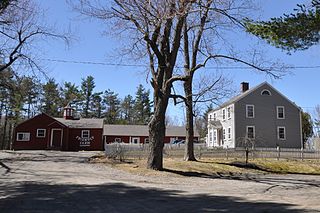
The Asa Morse Farm, also known as the Friendly Farm, is a historic farmstead on New Hampshire Route 101 in Dublin, New Hampshire. The main farmhouse, built in 1926 on the foundations of an early 19th-century house, is a good example of Colonial Revival architecture, built during Dublin's heyday as a summer retreat. The farmstead was listed on the National Register of Historic Places in 1983.

The Smith–Mason Farm is a historic farmstead at Meadow Road and Old Roxbury Road in Harrisville, New Hampshire. First developed in the late 18th century, the property has been adaptively used as a farm, summer estate, and family residence, representing major periods in Harrisville's development. The property was listed on the National Register of Historic Places in 1988.

The Scott Farm Historic District encompasses a historic farm property at 707 Kipling Road in Dummerston, Vermont. Developed between about 1850 and 1915, Scott Farm is a well-preserved farm and orchard complex of that period. It was listed on the National Register of Historic Places in 2001.
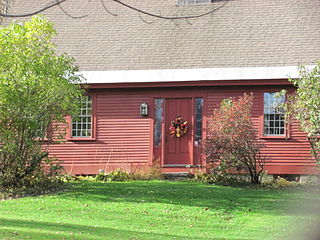
The Atherton Farmstead is a historic farm property at 31 Greenbush Road in Cavendish, Vermont. The farmhouse, built in 1785, is one of the oldest in the rural community, and is its oldest known surviving tavern house. It was listed on the National Register of Historic Places in 2002.
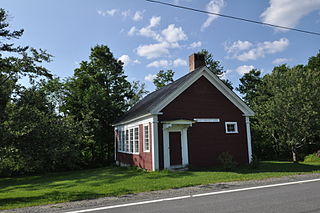
The Jericho Rural Historic District encompasses a rural agricultural landscape of northern Hartford, Vermont, extending slightly into neighboring Norwich. The area covers 774 acres (313 ha) of mainly agricultural and formerly agricultural lands, as well as associated woodlots, and includes nine historically significant farm complexes. It was listed on the National Register of Historic Places in 2001.

The King Farm is a historic farm property at King Farm Road in Woodstock, Vermont. Encompassing more than 150 acres (61 ha) of woodlands and pasture, the farm has 150 years of architectural history, include a rare 18th-century English barn. Originally a subsistence farm, it became a gentleman's farm in the late 19th century, and its farmstead now hosts a regional government commission. The farm was listed on the National Register of Historic Places in 1997.
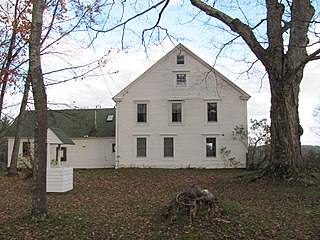
The Zachariah Spaulding Farm is a historic farmstead on South Hill Road in Ludlow, Vermont. With a history dating back to 1798, it is a well-preserved example of diversified 19th-century farmstead, made further distinctive by the remains of a sauna, the product of ownership by two Finnish families in the 20th century. It was listed on the National Register of Historic Places in 1993.
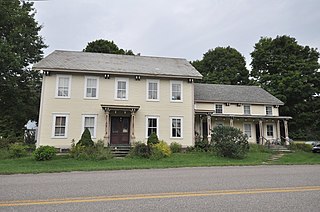
The Martin M. Bates Farmstead is a historic farm property on Huntington Road in Richmond, Vermont. Farmed since the 1790s, the property is now a well-preserved example of a mid-19th century dairy farm, with a fine Italianate farmhouse. The property was listed on the National Register of Historic Places in 1991.

The Jones–Pestle Farmstead is a historic farm property at 339 Bridge Street in Waitsfield, Vermont, United States. First developed in the 1820s, it is a well-preserved 19th-century disconnected farm complex. It was listed on the National Register of Historic Places in 2015.
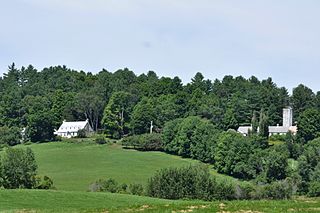
The William and Agnes Gilkerson Farm, also known more recently as the Kitchel Hill Farm, is a historic farmstead on Kitchel Hill Road in Barnet, Vermont. Established in the late 18th century by Scottish immigrants, it includes one of the finest known examples of a rubblestone farmhouse in the region. The property was listed on the National Register of Historic Places in 1992.

The Capt. Thomas Fanning Farmstead is a historic farm property at 1004 Shewville Road in Ledyard, Connecticut. With a building history dating to about 1746, it is one of the oldest surviving agricultural properties in the town, including the house, barn, and smaller outbuildings. The property, now reduced to 4 acres (1.6 ha), was listed on the National Register of Historic Places in 1992.

The William Noyes Farmstead is a historic farm property at 340 Gallup Hill Road in Ledyard, Connecticut. Dating to about 1735, it is a well-preserved example of a rural farmstead. It was listed on the National Register of Historic Places in 1992.






















